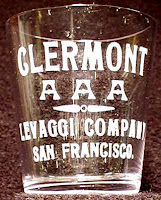 The pioneers in the family were Bernadino (aka Bernardo), born in 1842, and Giovanni (aka G.B.) born in 1844. They may have been brothers but certainly were close relatives. Bernadino appears to have been the first to have arrived in America and is recorded as having worked as a miner for 12 years. Giovanni, shown here, arrived in California from Lucca after 1865 and mined for eight years.
The pioneers in the family were Bernadino (aka Bernardo), born in 1842, and Giovanni (aka G.B.) born in 1844. They may have been brothers but certainly were close relatives. Bernadino appears to have been the first to have arrived in America and is recorded as having worked as a miner for 12 years. Giovanni, shown here, arrived in California from Lucca after 1865 and mined for eight years.Both Levaggis quit toiling for gold about the same time. In 1874 Bernadino went to San Francisco and opened a saloon. A city directory of 1880 recorded him running the establishment at 3 Vallejo Street. By this time he had married Mary Craviotto, an immigrant from Italy who had arrived in San Francisco as a girl. They would have six children, three sons and three daughters. Meanwhile, G.B. had established a fruit commission company called Levaggi & Barbiera.
Early in the 1880’s, reportedly for the health of a child, Bernadino left San Francisco and the saloon for Plymouth, California, a small town east of Sacramento in the foothills of the Sierra Mountains. There he began a general mercantile business that proved so successful that it became one of the most important enterprises in the region, according to
 contemporary accounts. Among key products for sale was liquor. Eventually two of his sons, Jules and Anthony, joined him. Bernadino used his increasing wealth to accumulate considerable property in San Francisco and became well known throughout the Bay District.
contemporary accounts. Among key products for sale was liquor. Eventually two of his sons, Jules and Anthony, joined him. Bernadino used his increasing wealth to accumulate considerable property in San Francisco and became well known throughout the Bay District.The effects of the the Great San Francisco Earthquake on Levaggi holdings are not recorded but Bernadino clearly saw an opportunity. Barely had the ashes cooled that his son Jules was sent to the city in 1907 to open a grocery and liquor store at 615-619 Front Street. Jules’ brother Anthony was listed as vice president. The Levaggis’ establishment included a whiskey blending facility.
By 1910, Levaggi & Company had outgrown its original quarters and moved to a three-story building at 333-339 Clay Street. With the move they abandoned the grocery
 department and concentrated on liquor. It was reported that they had become the West Coast representatives of “several large Eastern distilleries.” The firm issued several of its own brands, including “Royal Life Whiskey,” “High Life,” “Old Silver Creek,” “N.A. Hawkins,” and “Clermont.”
department and concentrated on liquor. It was reported that they had become the West Coast representatives of “several large Eastern distilleries.” The firm issued several of its own brands, including “Royal Life Whiskey,” “High Life,” “Old Silver Creek,” “N.A. Hawkins,” and “Clermont.” 
The company also claimed the Clermont Distilling Company at Clermont, Kentucky. The only distillery in that town, however, was the Murphy Barber Co., located on the Louisville & Nashville Railroad Line. It had been founded in 1880 with a capacity of 1,800 barrels annually and sold its product to a number of whiskey rectifiers. The Levaggis apparently were drawing on those supplies for its blends and felt comfortable claiming the distillery for their own, a common practice in the pre-Prohibition whiskey industry.

The close ties between Bernadino and G.B. were revealed when E. N. Cadenasso was named secretary of Levaggi & Co. He was married to Linda Levaggi, born in San Francisco and the daughter of Giovanni and Rose. G.B.’s son-in-law was working for Bernadino’s family firm. Moreover, in 1908 the two Levaggi companies had joined in a protest against certain U.S. Customs fees. Their pleas were summarily dismissed by authorities as “without merit.”

As National Prohibition began to draw a noose around the liquor trade, Levaggi & Co. in permissive California continued to thrive. Jules and his family moved from their home at 810 Union Street in 1917 to 1025 Green Street on Russian Hill. This home, now in an historic district, had been constructed in 1911 as an architectural mixture of the Mission Revival, Colonial Revival and Craftsman styles. Family descendants owned the house into the 1980s.

Probably seeing the coming end of the liquor business, Jules branched out into other areas. In 1919 he set up a dehydrating plant for making dried fruit. He also became well known in the Bay Area as an importer, according to one account, “building up a large and important business.” By contrast, Levaggi whiskey brands disappeared forever with the onset of National Prohibition in 1920.
Meanwhile, Bernadino was living in semi-retirement in Plymouth, from time to time visiting San Francisco. We assume one of those occasions was the funeral of G.B. who died in 1920. His son Jules would also succeed him in death in 1927. Bernandino died two years later, age 87. His obituary stated: “He continued his active interest in the mercantile business to the time of his death.” This pioneer Levaggi is buried in Plymouth Memorial Cemetery in the crypt shown here. His epitaph reads simply, “At Rest.”



No comments:
Post a Comment